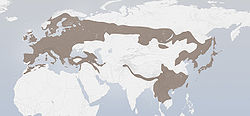| Garrulus | |
|---|---|
 | |
| Black-headed jay (G. lanceolatus), India | |
| Scientific classification | |
| Kingdom: | Animalia |
| Phylum: | Chordata |
| Class: | Aves |
| Order: | Passeriformes |
| Family: | Corvidae |
| Subfamily: | Corvinae |
| Genus: | Garrulus Brisson, 1760 |
| Type species | |
| Garrulus glandarius Linnaeus, 1758 | |
| Species | |
| |
Garrulus is a genus of Old World jays, passerine birds in the family Corvidae.











